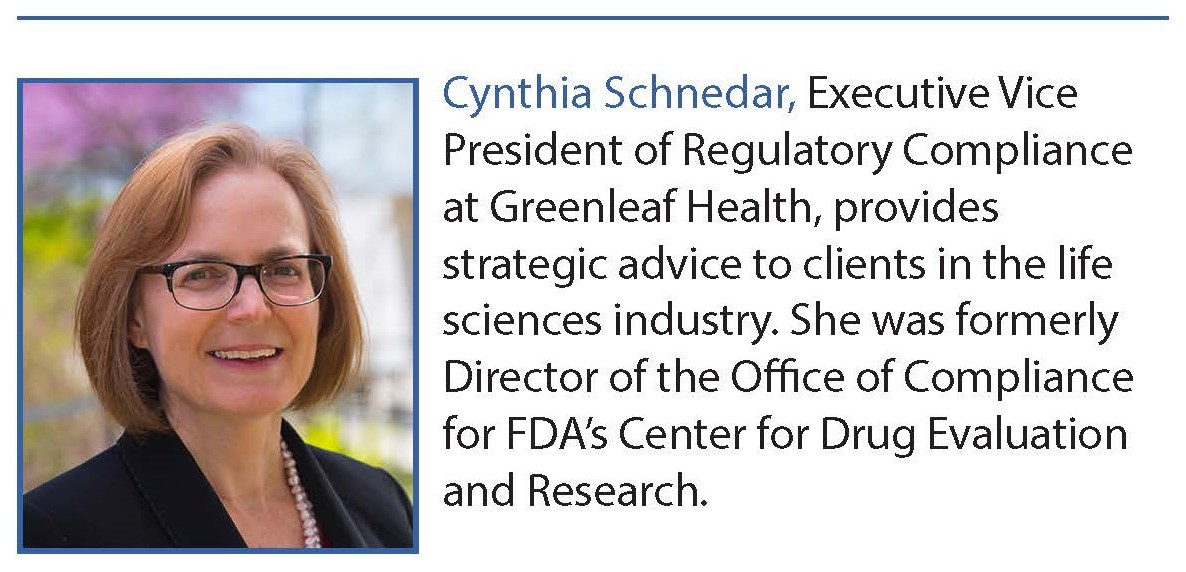
Eye on Enforcement
by Cynthia Schnedar
FDLI’s annual Enforcement, Litigation, and Compliance Conference for the Drug, Device, Food and Tobacco Industries always draws senior representatives from the Food and Drug Administration (FDA or agency) and from the U.S. Department of Justice (DOJ or Department), and thus offers a unique opportunity to become educated about any changes in the government’s enforcement priorities. This past December’s conference presented an especially valuable opportunity to gain such insight because it is the first FDLI enforcement conference held since President Trump assumed office and since Dr. Scott Gottlieb began his tenure as Commissioner of the FDA.
Priorities of the New Administration
During a keynote address opening the conference, FDA Chief Counsel Rebecca Wood noted that FDA’s public health mission is vast, yet its resources are limited, requiring FDA to make hard decisions every day in deciding how to best use its resources to protect the public health. She said Commissioner Gottlieb was directing the agency to use a risk-based approach in allocating resources by focusing its enforcement tools on the vulnerable patients or consumers who are most likely to suffer harm when FDA’s standards are not met.
Ms. Wood described some of the key areas that have garnered FDA’s enforcement resources during the past year, including:
- combating the synthetic opioid drug market;
- increasing oversight and enforcement actions against compounders that put patients at risk with products that fail to meet sterility requirements;
- taking enforcement against stem cell clinics that are taking advantage of vulnerable patients with unsupported claims about their products;
- targeting vendors who sell tobacco products to kids;
- issuing a health alert concerning lead testing kits that may give falsely low test results; and
- taking action to stop the sale of food products where the facility is contaminated with listeria, a pathogenic bacterium that can cause a life-threatening illness.
The focus on preventing harm to vulnerable patients and consumers was echoed in the keynote address given on the conference’s second day by Ethan Davis, Deputy Assistant Attorney General, Consumer Protection Branch, DOJ. However, Mr. Davis noted that DOJ is also concerned that its enforcement efforts do not stifle industry innovation. Thus, he said the Department is conducting a “rule of law” exercise designed to ensure it does not pursue “technical regulatory violations” that force companies to over-emphasize technical compliance issues even when there is no risk of harm to the consumer. Within that framework, Mr. Davis outlined three areas of enforcement priorities for the Department: opioids, dietary supplements, and compounding pharmacies.
Mr. Davis noted that in the past few months, DOJ spearheaded the “largest health care fraud takedown in history” by arresting over 50 doctors for opioid-related crimes. He also highlighted that DOJ will be taking enforcement actions against opioid manufacturers who fail to comply with the Risk Evaluation and Mitigation Strategies requirements imposed on their products by FDA.
Mr. Davis noted that in the dietary supplement industry, DOJ is focusing its enforcement on the “bad apples in a largely law-abiding industry,” and that its targets would be “those who lie” about what is in their product or what the product will do for the health of the consumers.
Mr. Davis said that in focusing on the compounding industry, DOJ would continue to seek either criminal prosecutions or civil injunctions to address “real safety problems” that have been associated with some compounded pharmaceuticals.
Individual Liability in Criminal Prosecutions and Civil Litigation
Both Ms. Wood and Mr. Davis gave intriguing clues during their respective keynote addresses as to the current Administration’s approach to the Park Doctrine. Lawyers in the defense bar have long criticized the Park Doctrine, which stems from the Supreme Court decision holding that, under the Food, Drug, and Cosmetic Act, a corporate official who stands in a responsible relation to the public danger can by virtue of his position be found guilty of a misdemeanor violation.
Mr. Davis acknowledged that the tool, which allows DOJ to secure a criminal conviction without having to show intent of the accused, must be used judiciously. In evaluating potential Park prosecutions, he said the Department must consider whether the unlawful conduct implicated public safety and whether there was “actual knowledge or willful blindness” on the individual’s part. Mr. Davis also said that DOJ tries to avoid “getting involved in good faith scientific disputes” because it does not want to stifle research or innovation.
In her separate remarks, Ms. Wood acknowledged that questions exist concerning “in what circumstances if any should FDA pursue what some have called ‘strict liability’ crimes.” She stated that FDA is carefully considering whether it can provide further clarification as to the circumstances in which FDA would pursue charging an individual in a supervisory role, and whether any breach of duty to act or to correct violations must occur before criminal charges should be brought.
Given these interesting remarks by both Mr. Davis and Ms. Wood, those of us outside the government will all be watching carefully for further illumination from either FDA or DOJ concerning what direction this Administration may take in its interpretation of the Park Doctrine. The first clue should come in the government’s response due in February to the writ of certiorari filed by the defendant in DeCoster v. U.S., a case where issues concerning the Park Doctrine are very much in play.
In the arena of civil litigation, speakers commented that the current Administration has not been hesitant to include individuals in actions against corporate defendants. Jennifer Bragg, Partner at Skadden, Arps, Slate, Meagher & Flom, pointed out that when the government agreed to sign a consent decree in 2017 with a major medical device company in lieu of filing a suit seeking a permanent injunction, the government required senior management officials be named as individual defendants in the decree even though those key individuals were not at the company during the time that the manufacturing problems occurred. Moreover, the consent decree requires that the company substitute another senior management official if the named individual defendant leaves the company. FDA’s request to have individuals named as defendants, even if the individuals were not present when the deficiencies occurred, is aimed at ensuring there are individuals at the company responsible for implementation and oversight of the decree during the life of the decree. However, Ms. Bragg noted that “it is not a small thing” to ask an individual to be named on a decree.
Compliance Central Updates
In addition to the broad overview provided by speakers who addressed topics spanning all industries, the conference also featured senior leaders from each of the FDA Centers’ offices of compliance, as well as key compliance and enforcement leaders from the Office of Regulatory Affairs (ORA). Through these speakers, conference attendees were able to gain a glimpse into FDA’s enforcement priorities applicable to each of the industries regulated by FDA.
Program Alignment and Its Impact on the Operations of All Compliance Offices
FDA speakers emphasized that ORA’s reorganization efforts, which have been in planning stages since 2013, are finally bearing fruit that will benefit all of FDA and the industries it regulates. While ORA was previously organized along geographic lines, as of this past year it is now aligned by commodity and more closely mirrors the structure of FDA’s centers. Representatives from ORA and from the Centers’ compliance offices observed that their offices are already working together in a more streamlined manner and are more prepared to meet the challenges presented by the globalization of the industries they regulate.
Drug Industry
We will shortly see tangible impact from ORA’s new program alignment reorganization in the inspections of human drug facilities. Two senior leaders in that area—Donald Ashley, Director of the Office of Compliance for the Center for Drug Evaluation and Research (CDER); and Alonza Cruse, Director, Office of Pharmaceutical Quality Operations, ORA—emphasized the significance of the new concept of operations agreement reached between CDER and ORA in 2017. The “ConOps,” as FDA insiders referred to it, aims to implement program alignment for drug inspections by using a team-based approach designed to improve FDA’s efficiency and consistency in decision-making. While the implementation goals for ConOps run through October 2018, FDA speakers said they already are starting to issue “90-day letters” that inform firms of their classification status within 90-days following a surveillance inspection. FDA and industry representatives said that the procedural reforms in the ConOps were long overdue and that the streamlined communications that will result should allow facility owners to more quickly address compliance issues at their facilities.
Mr. Ashley and Mr. Cruse also highlighted another significant milestone reached this past year—the signing of the 2017 annex to the Mutual Recognition Agreement (MRA)—which will allow FDA and its regulatory counterparts in the European Union (EU) to recognize and rely on each other’s Current Good Manufacturing Practices (CGMP) surveillance inspections, and in some cases, pre-approval inspections, of pharmaceutical facilities. Mr. Ashley noted that this agreement will allow FDA to avoid duplicative inspections in Europe and free up essential resources to focus on facilities in other parts of the world that are in greater need of oversight. While the shift of greater inspection resources towards India and China began long before the MRA was signed, we should see that shift in resources towards inspections outside the U.S. and Europe continue to grow significantly as the MRA is fully implemented.
Medical Devices Industry
Similarly, CDRH has a significant change coming in its global use of FDA’s inspectorate. Captain Sean Boyd, Deputy Director for Regulatory Affairs in CDRH’s Office of Compliance, noted that with the passage of the FDA Reauthorization Act of 2017 (FDARA), CDRH now has explicit regulatory flexibility to inspect medical devices based on risk rather than on a two-year time cycle. In addition, CDRH has the ability to recognize international auditing organizations for inspection purposes. Capt. Boyd also noted that CDRH is reorganizing a total product life cycle (TPLC) model where offices no longer will be based on regulatory functions (such as device evaluation or compliance) and will instead be based on device types (such as cardiovascular).
Capt. Boyd highlighted CDRH’s renewed efforts to take the least burdensome approach to medical device regulation, consistent with the least burdensome provisions that were introduced in the FDA Modernization Act of 1997 and revised by the FDA Safety and Innovation Act and the 21st Century Cures Act. Both Capt. Boyd’s remarks, and the draft guidance that FDA issued on this topic during the week following the conference, emphasized that CDRH would aim to request the minimum information necessary to adequately address the right regulatory question or issue.
Biologics Industry
Mary Malarkey, Director of the Office of Compliance and Biologics Quality, CBER, focused her remarks on the current high priority enforcement area for CBER that Chief Counsel Woods also highlighted—unapproved stem cell products that present significant risk to vulnerable patients. Ms. Malarkey stated that, consistent with the recently finalized guidance addressing the minimal manipulation and homologous use of human cell, tissues, and cellular and tissue-based products (HCT/Ps), her office will focus its enforcement efforts on the highest risk HCT/Ps. As examples of high risk, she cited HCT/Ps with high risk routes of administration and HCT/Ps intended for non-homologous use.
To demonstrate her point, Ms. Malarkey described two recent actions by the government in 2017—a warning letter CBER issued to a stem cell clinic with significant CGMP deficiencies and a seizure action by the U.S. Marshals of a live virus vaccine that a stem cell clinic was inappropriately administering to vulnerable cancer patients. Beyond the conference, it is already evident that CBER’s focus on non-compliant stem cell clinics is continuing into 2018 as CBER issued a warning letter on January 3, 2018 to a stem cell clinic for using processes that went beyond minimal manipulation and significantly deviated from CGMPs.
Food Industry
In the food arena, FDA is working hard to get both FDA staff and industry ready for new standards that are coming into effect on a rolling basis under the Food Safety Modernization Act (FSMA). Scott J. MacIntire, Director, Division of Enforcement, ORA, said FDA recognizes this is a major transition for both the agency and industry; thus, FDA will continue to “educate during, and while, we regulate.” Part of FDA’s education efforts include a newly created centralized bank of technical experts who are available to both FDA staff and industry to answer questions concerning FSMA. Mr. MacIntire said the agency is taking it slowly and using discretion on what to enforce as industry becomes more knowledgeable with the new requirements. However, he noted that the agency will still vigorously enforce the “old-fashioned” violations, such as stopping the sale of food products where the facility is contaminated with listeria, that pre-existed the creation of FSMA and that present a high risk to public health.
Veterinary Medicine Industry
Daniel McChesney, Ph.D., Director, Office of Surveillance and Compliance, Center for Veterinary Medicine (CVM) joined the conference to outline CVM’s enforcement priorities and actions. He noted several warning letters had been issued for unapproved animal drugs, covering companies that were marketing unapproved injectable cell-based products, unapproved Laminil and cancer products, unapproved cannabinoid products with claims to treat disease, and unapproved products that raised antimicrobial resistance concerns. Dr. McChesney also highlighted his office’s priorities for 2018, which include plans to implement an Animal Preventive Controls rule in the animal food industry and plans to address post-approval safety concerns and shortages.
Tobacco Industry
In panels covering regulation of tobacco production, consensus emerged that industry still is waiting for the Center for Tobacco Products (CTP) to provide more clarity. As Jeffrey Weiss, General Counsel and Executive Vice President of Government Affairs from NJOY, LLC noted, “Before we can talk about enforcement, we need to know what the rules are, and they are still being made.” Ann Simoneau, Director, Office of Compliance and Enforcement, CTP highlighted details from Commissioner Gottlieb’s July 2017 announcement on comprehensive tobacco and nicotine regulation and reiterated CTP’s goal of releasing several foundational rules in the near future. On the other hand, it is clear that the rules banning tobacco sales to minors are in place and the Retailer Compliance Check Inspection Program is in full swing. Ms. Simoneau noted that FDA and its partners completed over 168,000 inspections in Fiscal Year 2017 and issued over 1,400 warning letters.
Summary
Insiders at FDA and DOJ identified that their key areas of concern across industries over the coming year will be to protect vulnerable patients and consumers. Government representatives outlined their priorities in further detail, described the tools that are best suited to pursuing the government’s public health agenda, and expressed their intent to use those tools to advance that mission. Thus, for those in industry who may have been looking for a slowdown in enforcement efforts under this Administration, they will find themselves disappointed.
The information gained from the conference should help those in industry, and the lawyers who advise them, to take preventative actions that will address those public health concerns before any government action is necessary.
Update Magazine
January/February 2018






